Yogyakarta, located in the Central Java region of Indonesia, is the country’s second largest city and also the second most popular tourist destination after the island of Bali.
Pronounced as “Jogjakarta,” the city is commonly referred to as “Jog-Ja.” Due to hosting numerous traditional kingdoms over the centuries, Yogyakarta holds great significance as a city of history and temples in Indonesia.
Yogyakarta Special Region is one of Indonesia’s 32 provinces and is still governed by a Sultan. It is renowned as the center of classical Javanese art and culture.
During the Indonesian National Revolution from 1945 to 1965, the city, which served as the capital of Indonesia, possesses the distinction of being a city of culture and temples. Situated on the slopes of the active Mount Merapi volcano, it is one of the most ideal places for volcano exploration.
Being a vibrant and lively city, it readily accommodates the shopping inclinations of enthusiasts. In this city, you can shop to your heart’s content and even participate in batik-making workshops, experiencing the opportunity to create local products with your own hands.
Best Time To Visit Yogyakarta
We’d like to emphasize that the tourist city of Yogyakarta in Indonesia’s Java region experiences two distinct seasons. Visiting tropical countries often entails the unpredictability of getting caught in tropical monsoon rains at any moment, making it crucial for visitors to consider which seasons have less rainfall before traveling to such destinations.
When we say two seasons, it means these seasons refer to the dry and wet periods. The wet season, characterized by heavy rainfall, occurs between October and March. Within this period, it’s important to remember that December to February receives the highest amount of rainfall. So, if possible, avoid passing through or near Yogyakarta during December to February!
The period from June to October is the best time to visit the city as it experiences lower rainfall.
Due to its proximity to the equator, Yogyakarta maintains an average temperature of around 30 degrees Celsius throughout the year.
How To Get Yogyakarta
If you prefer to travel by plane to the city, you should be aware that you will land at Adisucipto International Airport. The airport is located 8 km east of the city. Flights are frequently available from Bali, Jakarta, Sumatra, Kalimantan, and Sulawesi.
For international flights, there are flights from Kuala Lumpur and Singapore (three times a week).
As for intercity transportation, the cheaper option is the bus. The main bus terminal is Giwangan. The terminal is situated 4 km southeast of the city. You can easily find buses to Jakarta, Surabaya, and Badung.
Transportation Within The City
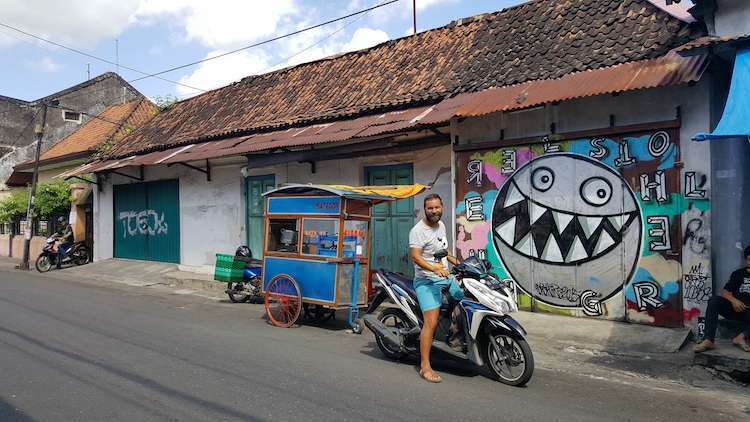
The cheapest way to explore the city is undoubtedly by walking. Besides that, other options are up to your preference. Here’s what we recommend:
We mentioned that walking is the cheapest option. The only thing you need is an English map. You can obtain a map from the airport, train station, or the tourist information right next to Hotel Mutiara on JI. Malioboro Street.
The second option for getting around is by taxi. The taxi meter starting fare in the city is 5,500 IDR, and the night rate starts at 10,000 IDR.
The third option is using “becak,” which are bicycle rickshaws, and “andong,” which are horse-drawn carriages.
The last option, renting a scooter or a vehicle, is the best way to explore the city. We paid a daily fee of 100,000 IDR for it. Since we didn’t rent within the city, we probably overpaid ☹ We are aware that this fee might be considered expensive for Southeast Asia, but we didn’t have any other choice. Normally daily rental prices are between 65K to 90K IDR.
Places To Visit In Yogyakarta
In the city that welcomes millions of visitors from all around the world throughout the year, historical temples, museums, and markets are among the top places to visit. The first places that come to mind are undoubtedly the Buddhist and Hindu temples, Borobudur and Prambanan. Both of these temples are listed as UNESCO World Heritage Sites. By clicking on the numbered locations on the map below, you can find the locations of the places to visit.
1Borubodur Temple
2Kebun Teh Nglinggo
3Kedung Pedut Waterfall
4Wisata Kalibiru
5Menoreh View
6Grojogan Watu Purbo
7Merapi Volcano
8The Sultan’s Palace – Yogyakarta Palace
9Taman Sari
10Jalan Malioboro
11Affandi Museum
12Prambanan Temple
13Ratu Boko Temple
14Luweng Sampang Waterfall
15Sri Gethuk Waterfall
16Jomblang Cave
BOROBUDUR BUDDIST TEMPLE
It is the world’s largest and single-piece Buddhist temple. Do not compare it with Cambodia’s Angkor because that is not a temple but a complex. Located 40 km northwest of the city of Yogyakarta, the temple was designated as a UNESCO World Heritage Site in 1991.
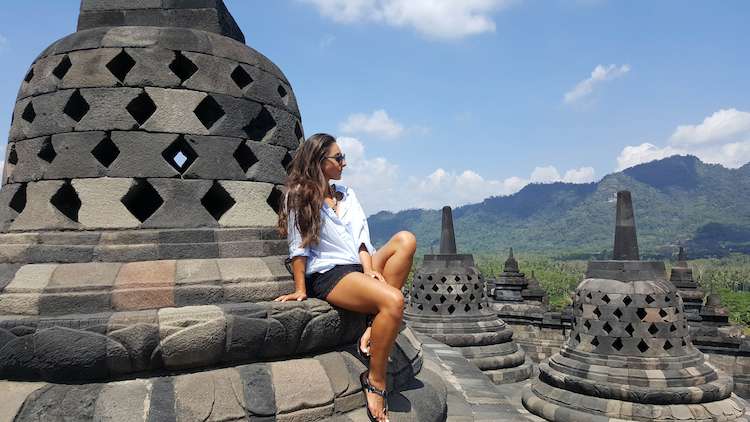
According to official records, it is not known who built Borobudur and for what purpose. Based on available information, it is known that the construction year is around 750 AD, during the period of the Sailendra dynasty’s development. The construction is estimated to have taken about 75 years and was completed during the rule of Samaratungga around 825 AD.
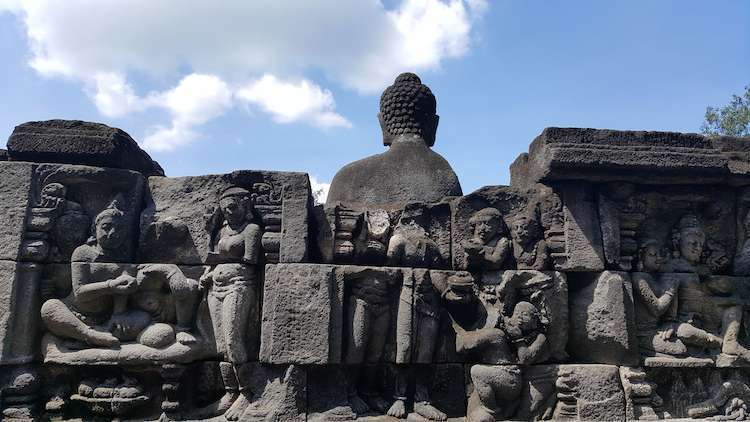
The structure, abandoned and even forgotten by the people, remained hidden under volcanic ash for centuries. It was rediscovered in 1814 by Sir Stamford Raffles. The initial restoration efforts were initiated by the Dutch, and later with the support of UNESCO (25 million dollars), the restoration continued for 11 years, reclaiming it for humanity. In 1991, it was inscribed on the UNESCO World Heritage List.
Two million blocks of stone, each weighing 40 kilograms, were individually numbered and meticulously placed during the restoration process. Within these 2 million stone blocks, there are 504 Buddha statues, 2,760 reliefs, and 72 stupas around the main dome. When viewed from above, the structure’s mandala shape becomes quite apparent.
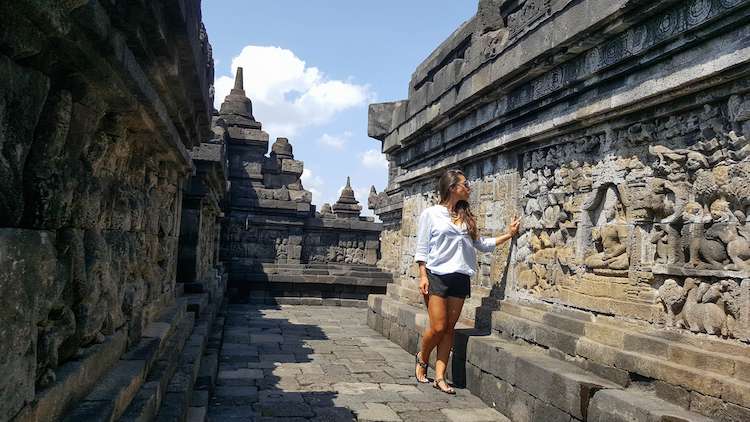
Note: Before visiting the site, you can dress as you please. You won’t be given a sarong to cover up just because you’re wearing shorts or sleeveless clothes.
Entrance Fee: Entrance fee of 355,000 IDR is required. The student fee is 210,000 IDR. If you have a student card, be sure to bring it with you.
Visiting Hours: Between 04.30 AM to 5:00 PM
You can find information about the park’s entrance fee, rules, and other details on the official Borobudur website.
KALIBIRU NATIONAL PARK
Kalibiru, which has gained popularity on social media in the last two years, is truly a paradise for those seeking an escape within nature.
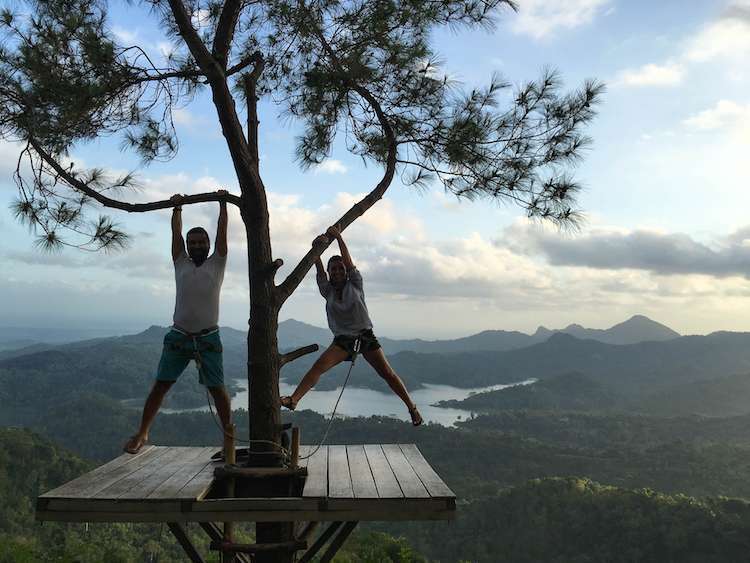
Previously, due to wildfires and illegal stays, the area of Kalibiru was dry and neglected. However, within five years, thanks to the efforts of the Mandiri Farmer Group, it underwent significant restoration and turned green and natural. The management of this extensive area was handed over to the local community for a duration of 35 years.
The increasing popularity of Kalibiru National Park on Instagram isn’t solely about taking photos. Yes, photography is one of the main activities and a must-do. Sometimes, you might even wait for hours for your turn to take pictures. We waited for about an hour ourselves.
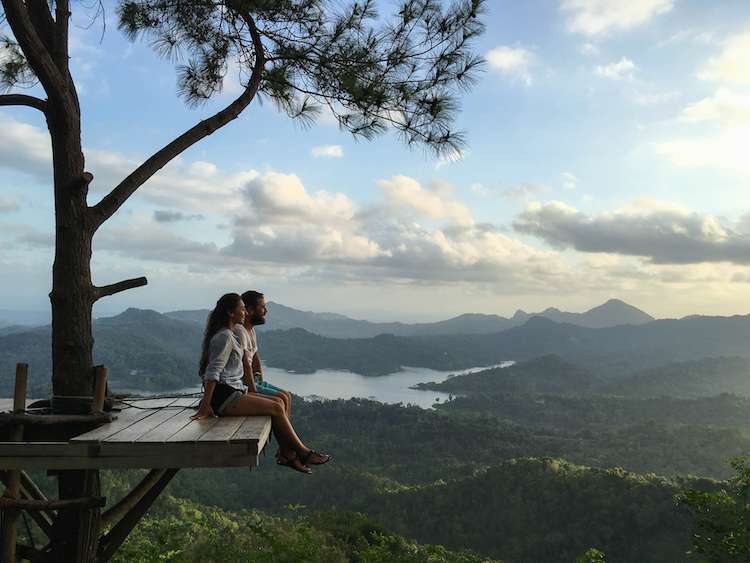
There are numerous spots where you can take photos. You can pick any spot that catches your eye, take your photo there, and then start exploring the surroundings.
KEDUNG PEDUT WATERFALL
Just 15 km away from Kalibiru National Park lies a hidden gem. Since most visitors come primarily for Kalibiru, you can enjoy a peaceful and quiet time at the waterfall, either on your own or with a few people, undisturbed by crowds.
SAMIGULAH TEA PLANTATION – KEBUN THE NGLINGGO
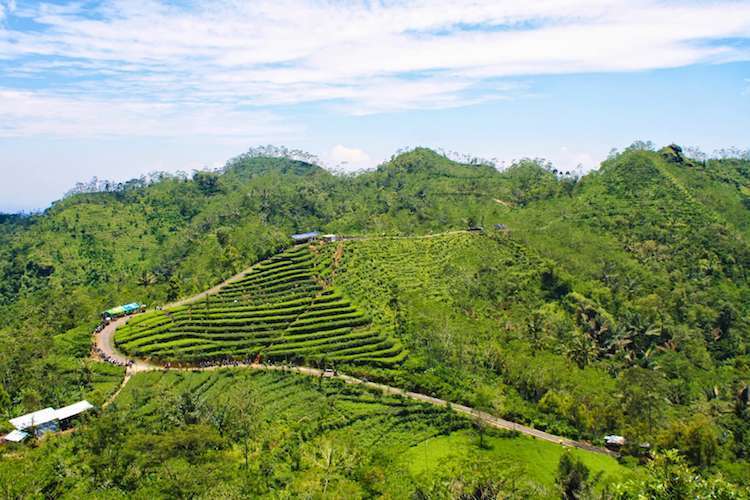
You can explore tea plantations that resemble the beauty of rice terraces in Ubud. They are located not far from Kalibiru National Park, around 37 km away.
MENOREH HILL – MENOREH VIEW
From Kalibiru National Park, you can head 53 km north to a hilltop and experience an unforgettable sunrise early in the morning.
As for outdoor activities, the park not only offers natural beauty but also provides enjoyable experiences for outdoor enthusiasts. These include adrenaline bridges, climbing, and zip-lining, just to name a few. We recommend visiting during 06:00-10:00 for sunrise and 15:00-18:00 for sunset to make the most of your experience.
Entrance Fee: 50K IDR
How To Get There:
The National Park in the Kulon Progo region to the west of Yogyakarta is about 1.5 hours away from the city and 1 hour from the Borobudur Temple.
Upon reaching the National Park, you can park your motorcycle in the designated areas and then embark on a short but steep climb to reach the ticket counter.
GROJOGAN WATU PURBO
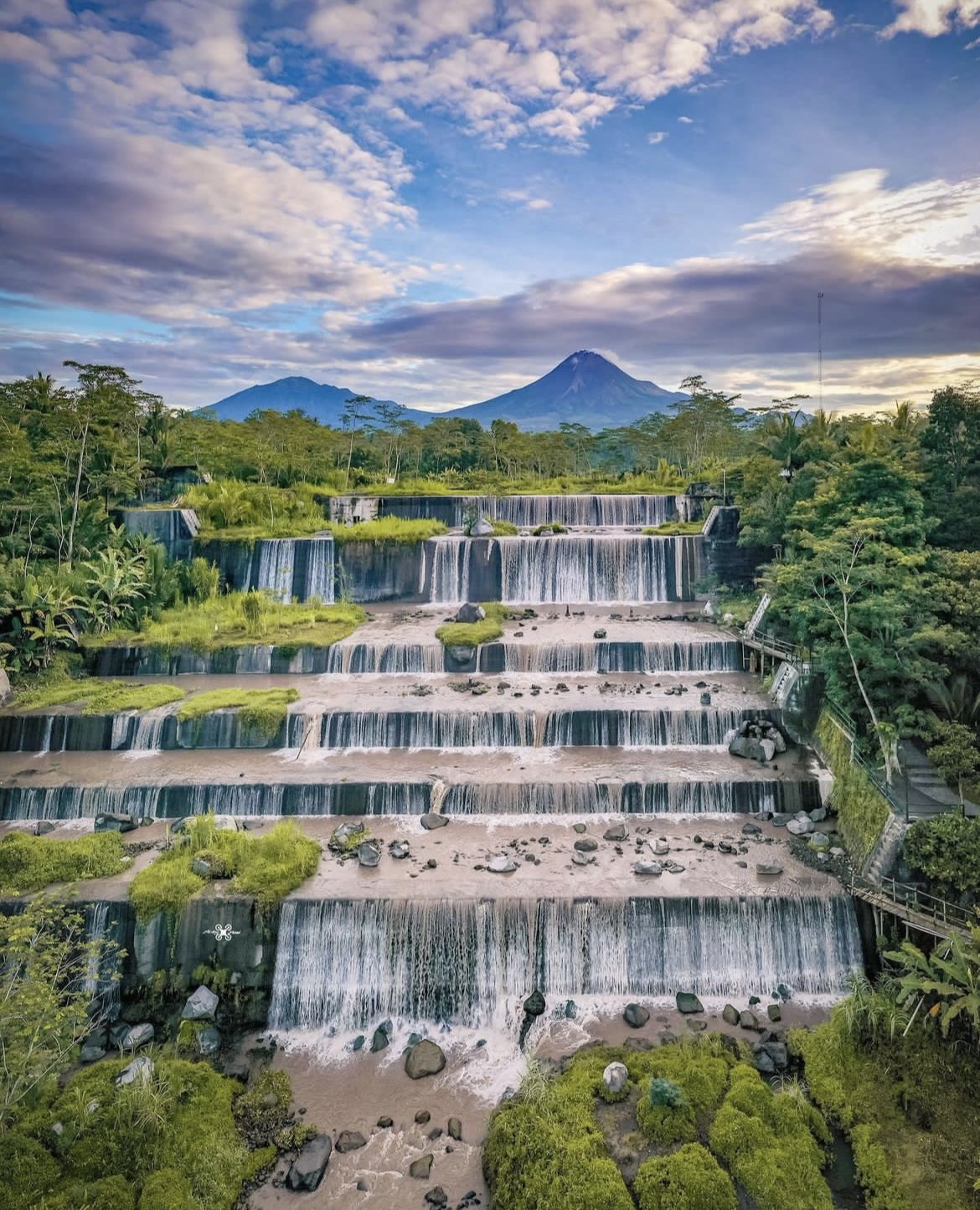
Grojogan Watu Puro, the most popular waterfall in recent years, is a magnificent 6-tiered waterfall. It’s often referred to as the “Niagara Falls of Yogyakarta.” However, Grojogan Watu Puro is not a natural waterfall. It was formed in 1975 as a result of the eruption of Mount Merapi, which created a dam. Swimming isn’t advisable at this waterfall. The main reason to visit here is to witness the view of Mount Merapi behind the waterfall. For this, you should definitely choose to visit during sunset.
Since there is no public transportation, the only way to reach this waterfall is by private vehicle or by renting a motorcycle. There is no entrance fee for the waterfall, but you will need to pay a small fee for parking.
MERAPI VOLCANO
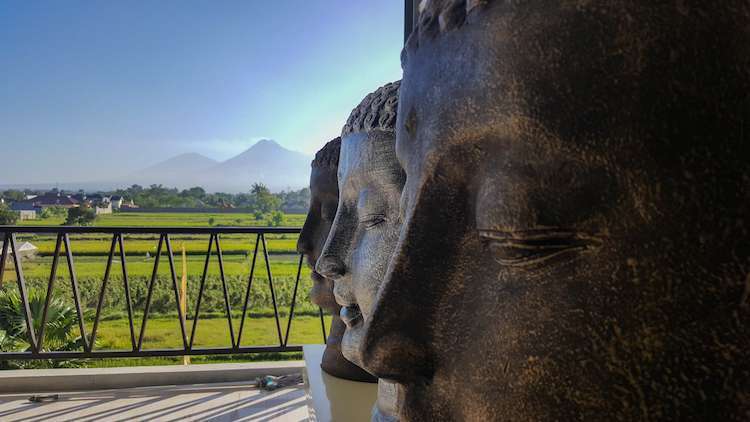
Known as the “Fire Mountain,” Mount Merapi is an active volcano located in the Java region of Indonesia, standing at a height of 2,913 meters. This volcano has been erupting lava consistently since 1548, and its smoke can be seen on about 300 days of the year.
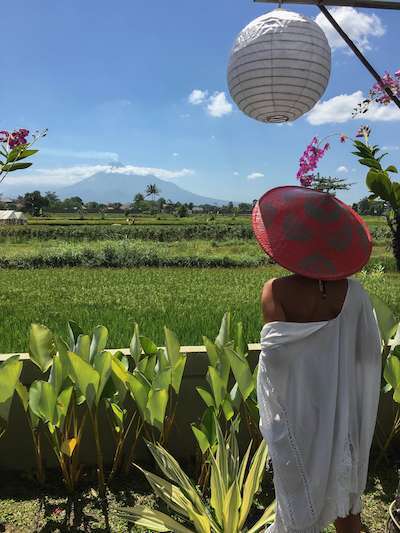
One of the most significant activities that should be experienced in Yogyakarta is climbing Mount Merapi and watching the sunrise. The ascent begins at 01:00 at night, and after 5 hours, you’ll be greeted with a magnificent sunrise above the clouds.
Being part of a tour is necessary for this, and the route to follow after this stage includes: Sela – Selakopongiser – Selakopoduwur – Pasar Bubrah (2600 meters) – Puncak Merapi (2913 meters).
THE SULTAN’S PALACE – KRATON
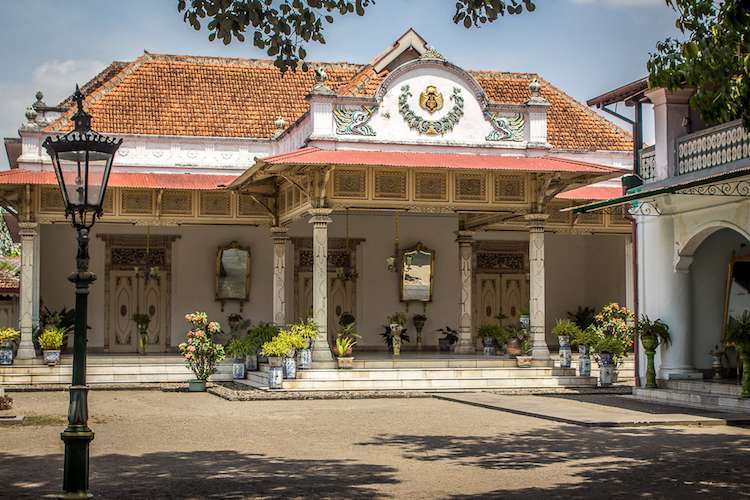
The grand complex, known as “Kraton” or “Karaton,” meticulously reflects the intricate Javanese court system. The extraordinary traditional Javanese architectural examples you’ll see within the complex are unparalleled. The construction of the palace was completed in the year 1790.
The front courtyard of the palace (the northern square) is referred to as “Alun Alun Utara,” while the rear facade (the southern square) is called “Alun Alun Selatan.”
Today, Kraton Yogyakarta is a part of the tradition. Besides being the living area for the Sultan, it continues to serve as a complex for ceremonies and cultural performances.
Visiting Hours: Except for Mondays, the complex is open from 08:00 to 14:00 on all other days.
Perform Hours
Monday-Tuesday : Gamelan music 10:00 AM
Wednesday : Golek Menak Puppet 10:00 AM
Tuesday : Dance Show 10:00 AM
Friday : Macapat 09:00 AM
Saturday : Puppet Show 09:30 AM
Sunday: Puppet and Dance show 09:30 AM
Entrance Fee: 15K IDR
TAMAN SARI – WATER CASTLE
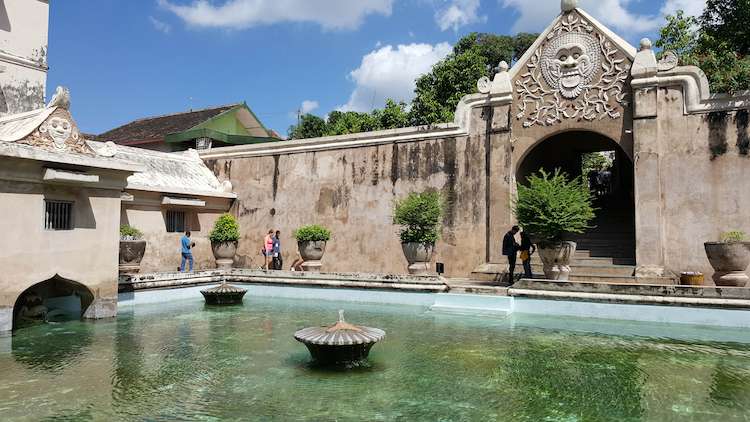
Located in the old part of the city and to the west of the Keraton (palace), Taman Sari was constructed in the mid-18th century. As a part of the Yogyakarta Palace complex, Taman Sari is one of the places worthy of being listed as a UNESCO World Heritage Site.
When you look at its architecture and reliefs, it’s evident that the complex blends Hindu, Islamic, Buddhist, Chinese, and European elements. Spread over a 10-hectare area, the Water Palace features pools, hanging bridges, artificial lakes, and underground tunnels. Out of the 58 structures within the complex, 22 are still noticeable today.
Within the palace, there are three pools. One is for the Sultan’s daughters and sisters, another for his 35 concubines, and the third, which is special, is for himself and his wife.
Upon entering, guides approach you. If you wish to explore in more detail, you can arrange for their assistance. This way, you can gain in-depth knowledge about the history and intricacies of the structure. If history isn’t very important to you and you’re just looking to wander around and take a few photos, you might not need a guide. However, when visiting this city, don’t leave without seeing Taman Sari, which has become a cultural icon of Yogyakarta.
Entrance Fee: 15K IDR
Visiting Hours: 09:00 – 15:00
Underground Mosque
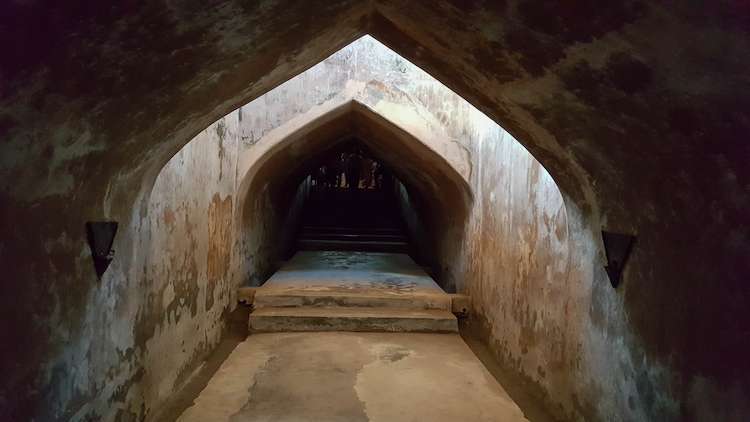
The main complexes that should be visited are the Umbul Binangun complex with its pools and the Pulo Kenongo complex with its underground mosque.
MALIOBORO STREET
Every city has its essential bustling, tourist-filled street, right? Well, Yogyakarta’s busiest street is Malioboro. It’s a place where guest houses, restaurants, and shops come together, and it’s the most crowded spot with both pedestrian and vehicle traffic. We can’t say we were particularly fond of this area. That’s why, instead of spending our time wandering around here, we prioritized visiting other places worth seeing.
AFFANDI MUSEUM
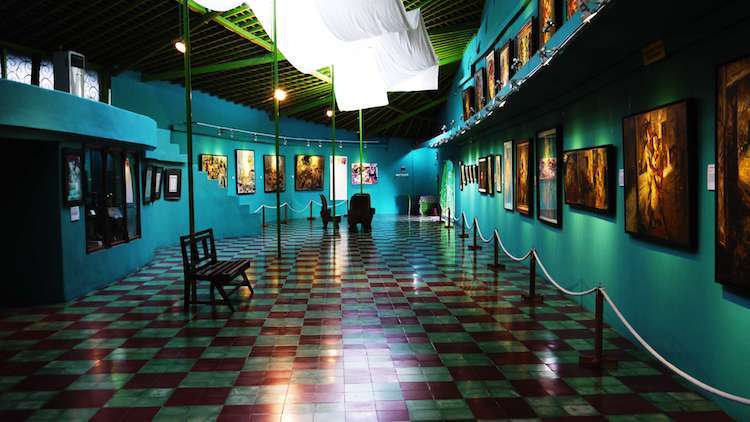
The most renowned artist of Indonesia, Affandi, lived and practiced his art in the house where he resided until his death in 1990. Located 6 km to the east of the city center, the museum showcases artworks by Affandi and his daughter Kartika. After Affandi passed away, he was buried in the backyard of the house where he had lived.
PRAMBANAN TEMPLE
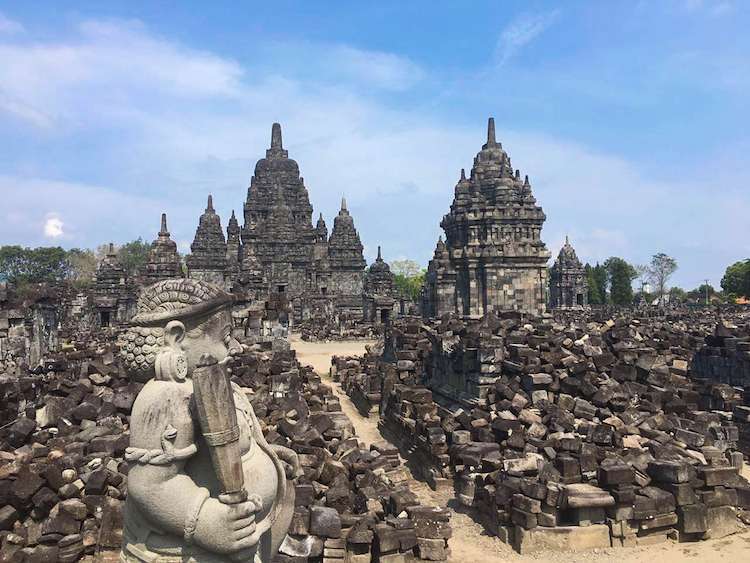
After the world’s largest Buddhist temple, it’s time for the world’s most beautiful, Indonesia’s largest Hindu temple. This is the largest temple complex in the Java region. There are three main temples, each dedicated to the Hindu deities Shiva, Vishnu, and Brahma. According to Hindu belief, this temple complex is adorned with symbols of the three deities (Trimurti).
Within the complex, there are 3 Trimurti temples, 3 Vahana temples (Nandi, Garuda, Hamsa), 2 Apit temples, 4 Kelir temples, 4 Patol temples, and 224 Pervara temples. And not to forget the reliefs on the temples as well.
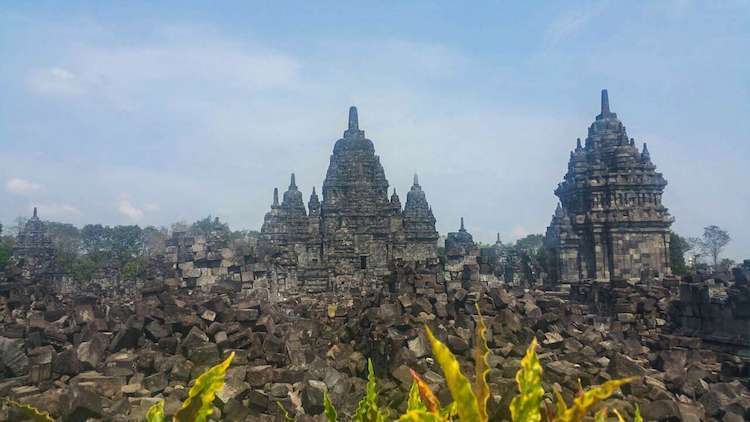
According to historical records, this temple complex was built by the Hindu prince Rakai Pikatan of the Sanjaya dynasty, 50 years after the construction of Borobudur in the 9th century AD. Originally, the complex was composed of over 250 large and small temples. In the 10th century, most of the temple complex was abandoned when the Mataram Dynasty moved to the eastern part of Java.
By the 16th century, after experiencing earthquakes and being looted, the fate of the complex was left in ruins. The restoration process began in 1937. While exploring the temple, you can still see piles of rocks and the fact that they haven’t been restored yet.
Entrance Fee: 25 USD
You can find information about the park’s entrance fee, rules, and other details on the official Prambanan website.
RATU BOKO TEMPLE
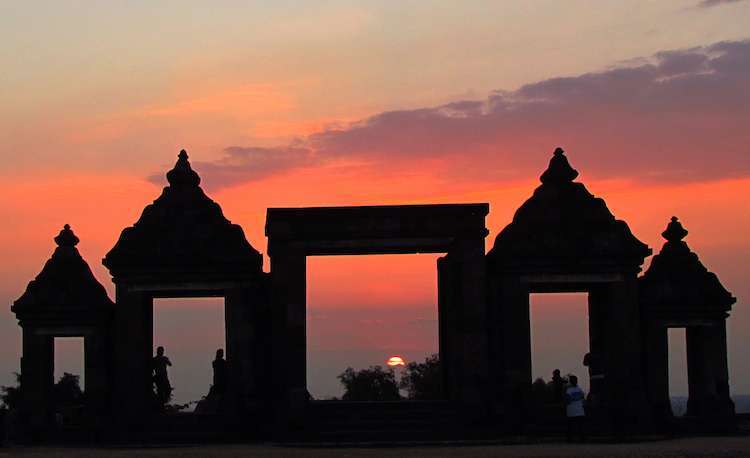
The temple where Buddhist and Hindu architecture blend, located 3 km east of the Prambanan temple, is one of the essential spots for sunrise. It stands out from the other temples in Yogyakarta with its exotic atmosphere. Being built on a hill, you can also see the Prambanan temple from this location.
Built on a 16-hectare area, the temple was initially used as a residence for the Boko Kingdom of the Mataram Dynasty. Mantras and a Bodhisattva statue were discovered here in the year 792 AD. Among the Hindu remnants, lingga and Ganesha statues are also found within this temple complex.
If you purchase a combined ticket for Prambanan and Ratu Boko, you can use the shuttles within the complex to reach Ratu Boko. Make sure to inquire about this at the ticket counter.
Transportation: Located 19 km east of Yogyakarta in the Piyungan region, within the boundaries of Dawung and Sambirejo villages.
For information about entrance fees, rules, and other details about the park, you can visit the official Ratu Boko website.
LUWENG SAMPANG WATERFALL
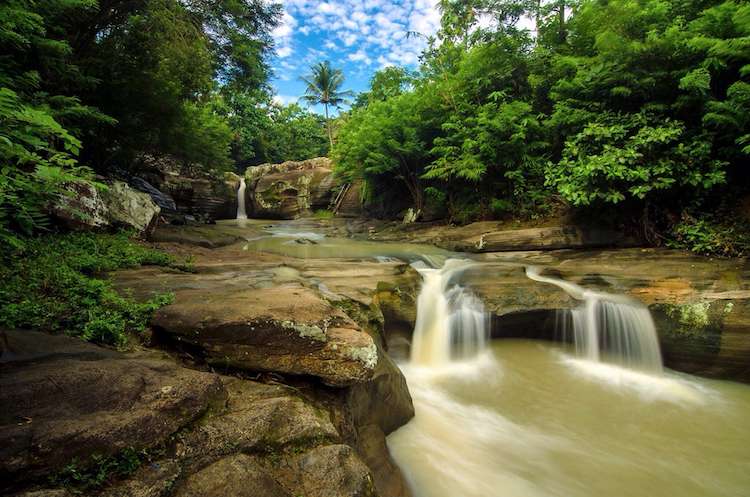
It’s a stunning waterfall with canyons. It’s similar to the Kawasan Falls in the Philippines but much smaller. It’s a remarkable place for nature enthusiasts as well as photographers.
AIR TERJUN SRI GETHUK
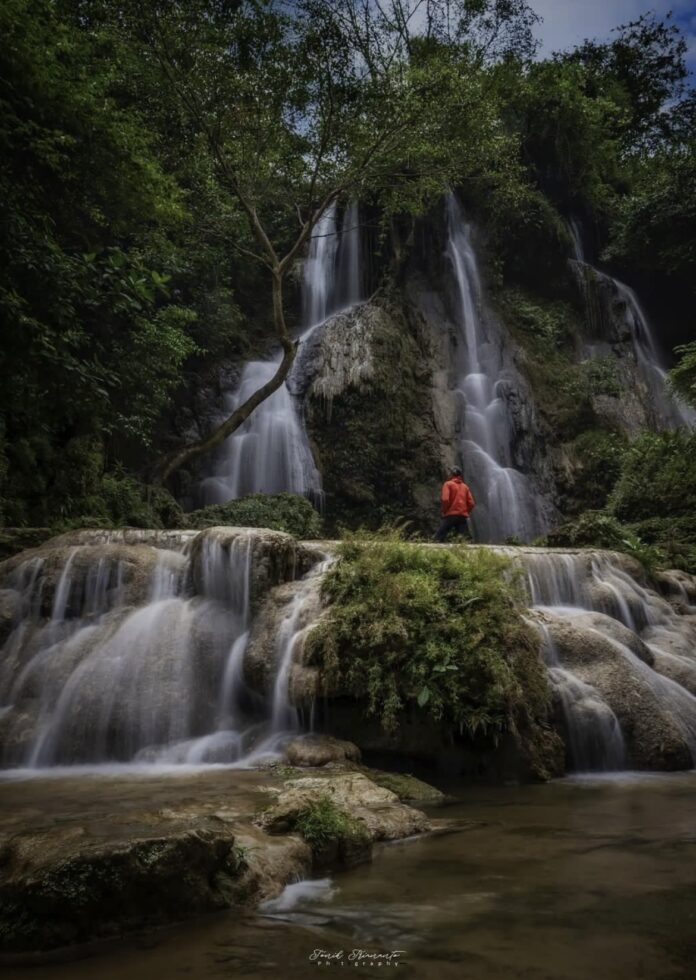
Since there is no public transportation to this waterfall, the best solution is to rent a motorbike and go there. You can find the location using apps like Map.Me and Google Maps. If you have trouble finding the waterfall, you can ask the locals for directions. The entrance fee to the waterfall is 25,000 IDR.
GOA JOMBLANG – JOMBLANG CAVE
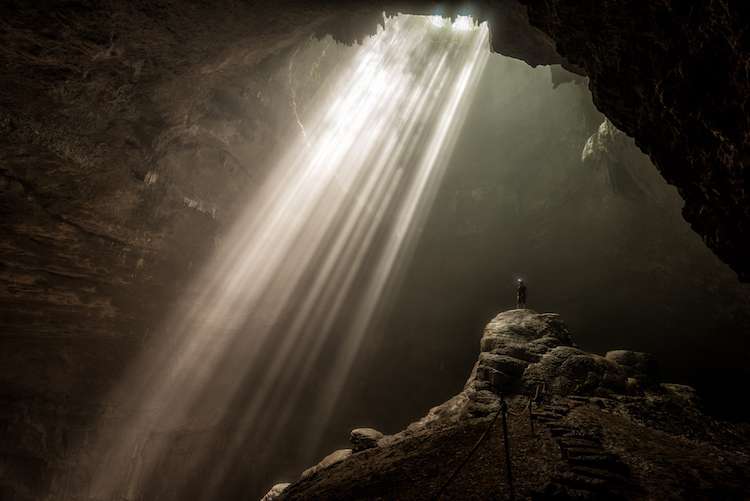
This cave, with its immense size and meters-high ceilings, offers mesmerizing light displays that will make you question your eyes. The effect of the rays filtering in from the open area on top is the precursor to its magnificent atmosphere. Calling it just a cave would be inaccurate; it’s actually part of a cave system.
The cave has been formed over years through the erosion of karst rocks by rainwater and underground rivers. You could say it’s somewhat similar to the Yucatan cave in Mexico.
The cave has three sections: the first section is the area with the hole on top, the second one is the part with the long tunnel, and the last one is the main cavern area.
We recommend being here very early in the morning. Since only 25 people are allowed each day, and the hours when direct sunlight enters the cave are between 10:00 AM and 12:00 PM, you should aim to arrive by 10:00 AM at the latest. It takes about 1.5 hours by car or motorbike from Yogyakarta.
The last 200 meters of the road before reaching the cave are quite rough. However, you’ll have suitable shoes for the cave entrance ☺ If you don’t want to clean the mud from your shoes and socks after exiting the cave, you can carry slippers to wear inside the cave. Once you reach the entrance point, you’ll need to descend about 50 meters while attached to ropes. After the rope part, it’s all about your footing. There are no difficult or tiring stages, as the entrance is quite easy and enjoyable.
Wear swim shorts and your swimsuit underneath, just in case. You might get the chance to swim in the river inside the cave
Here are some things you should consider bringing with you:
Comfortable Shoes
Raincoat
Under water camera
Headlamp
Other Waterfalls in Yogyakarta
Sri Gethuk Water Fall
Air Terjun Setawing
Air Terjun Grojogan Sewu
Air Terjun Grojogan Mudal
Air Terjun Kembang Soka
Air Terjun Kedung Pedut
Air Terjun Banyunibo, Patuk
Curug Indah Gedangsari
Curug Gede
Air Terjun Jurug Lengkongsari
Air Terjun Goa Selarong
Air Terjun Jurang Pulosari
Air Terjun Parangtritis
Air Terjun Pantai Jogan **** The waterfall cascades onto the Jogan beach.
Read all articles about Indonesia
